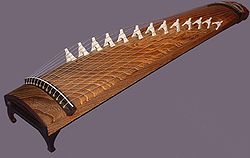Koto (musical instrument)
 |
|
| String instrument | |
|---|---|
| Other names | 13-stringed koto |
| Classification | |
| Hornbostel–Sachs classification | 312.22-6 (Heterochord half-tube zither sounded with three plectrums) |
| Inventor(s) | Kenjun |
| Developed | 16th century |
| Related instruments | |
| 17-string koto, zheng, yatga, gayageum, đàn tranh | |
The koto (Japanese: ) is a traditional Japanese stringed musical instrument derived from the Chinese zheng, and similar to the Mongolian yatga, the Korean gayageum, and the Vietnamese đàn tranh. The koto is the national instrument of Japan. Koto are about 180 centimetres (71 in) length, and made from kiri wood (Paulownia tomentosa). They have 13 strings that are usually strung over 13 movable bridges along the width of the instrument. There is also a 17-string koto variant. Players can adjust the string pitches by moving the white bridges before playing. To play the instrument, the strings are plucked using three finger picks, otherwise known as plectra, (on thumb, index finger, and middle finger).
The character for koto is , although is often used. However, 琴 usually refers to another instrument, the kin (琴の琴; kin no koto). 箏, in certain contexts, is also read as sō (箏の琴; sō no koto). However, many times the character 箏 is used in titles, while 琴 is used in telling the number of kotos used.
The ancestor of the koto was the Chinese zheng and was first introduced to Japan from China in the 7th and 8th century. The first known version had five strings, which eventually increased to seven strings. (It had twelve strings when it was introduced to Japan in the early Nara Period (710–784) and increased to thirteen strings). This particular instrument is known throughout Asia but in different forms: the Japanese koto, which is a relative to the Chinese zheng, the Korean gayageum, and the Vietnamese dan tranh. This variety of instrument came in two basic forms, a zither that had bridges and zithers without bridges.
...
Wikipedia
